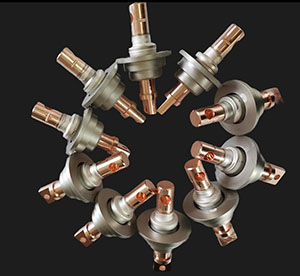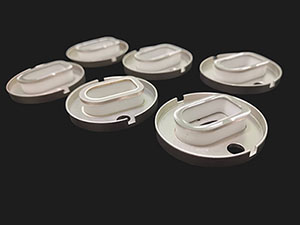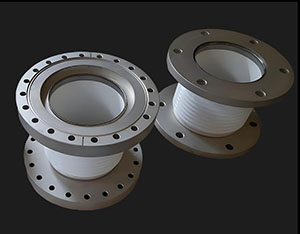Ceramic brazing/ceramic welding
Vacuum brazed ceramic-metal seal assemblies are most commonly used in electrostatic particle accelerator tubes, microwave tubes, semiconductor feeds, laser components, transmission signal filtering, medical, particle accelerators, space exploration, nuclear industry, aerospace accessories, insulation materials....The key to ceramic-metal structures depends on vacuum integrity and dielectric properties, the so-called seal quality. The difficulty of vacuum brazing ceramic-metal seal assemblies is largely due to the fact that most brazing alloys cannot directly "wet" the ceramic material, and once the material successfully "wets", residual stress will accumulate. The three factors that affect successful vacuum brazing are:
1. Material selection, 2. Joint design, 3. Wettability.

Brazing ceramics and metals are mainly Kovar alloy, which uses the high temperature stability and chemical stability of ceramics to firmly connect the Kovar alloy and ceramics together. This brazing process not only ensures the stability and reliability of the connection, but also effectively reduces problems caused by thermal stress and thermal expansion mismatch.
Ceramic welding is another common process used to join two or more ceramic components. The ceramic welding process includes multiple steps such as preheating, welding material selection, welding equipment selection, and welding operation technology. Each parameter also needs to be strictly controlled to ensure the quality and reliability of welding.
Before ceramic brazing and ceramic welding, strict surface treatment must be carried out on the parts to be connected to ensure that the joints are clean and flat. In addition, appropriate brazing and welding materials need to be selected to ensure their compatibility and stability with the parts being connected. At the same time, it is also necessary to select suitable brazing equipment and welding equipment to ensure that it can provide sufficient temperature and pressure for brazing and welding.
After brazing and welding are completed, a leakage test is also required to ensure the sealing and reliability of the connection. Air leakage testing usually includes pressure testing and vacuum testing to ensure the reliability of the connection parts in high pressure or vacuum environments.
With the continuous advancement of science and technology, ceramic brazing and ceramic welding processes are also constantly innovating and improving. The most advanced new technologies include laser brazing, plasma brazing, ultrasonic welding, etc. These new technologies can improve the efficiency and accuracy of brazing and welding, and can also be applied to more types of materials and shapes.
In product manufacturing, ceramic brazing and ceramic welding processes play a very important role. By strictly controlling various process parameters, selecting appropriate materials and equipment, and applying the most advanced new technologies, we can ensure that our products have excellent performance and reliability, and can also meet the use requirements under different working conditions.
Our actual case
In 2019, we assisted an Australian company to successfully complete ceramic and Kovar ceramic welding joints, and improved the LEAKAGE RATE <1.0E-9 mbar.l/s [5.0E-9 atm. cc/s], and tested each object for Leak Testing uses video recording to replace manual data reporting. (More)


- About usLONGYI
- Products
- Advanced Ceramic & Fine Ceramic
- Hard and brittle materials processing
- Contact Us
- News
- Antistatic-ceramic suction cups officially enter the KLA supply system
- Chinese New Year Celebration Announcement
- Since the epidemic of COVID-19 is serious, the production staffs work separately by turns. Delivery time must be affected by process extension.
- Porous Ceramic Vacuum Chuck + Granite Base
- Company relocation notice
- Ceramic characteristics
- Ceramics Gas Tube ASSY
- Die bonder Dispensing Pin 45mil D/B
- Fittings
- Ceramic Ferrule
- Tokyo Weld / Tester / Packaging Machine / Ceramic Index table
- Ceramic Nozzle
- Ceramic Nozzle
- Ceramic Nozzle
- Die bonder Dispensing Pin D/B
- Porous ceramic vacuum chuck
- Advanced Ceramic & Fine Ceramic
|
LONGYI PRECISION TECHNOLOGY CO., LTD.
Address : No. 705, Longxing Road, Chungli District , 32091, Taoyuan, Taiwan
Tel : +886-3-466-6611 Fax : +886-3-466-7722 |
Designed by MIRACLEWeb Design
